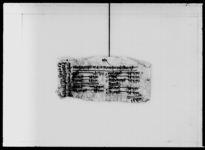A directive to susāres to get their wheat allowance from Rājabala Ḍoṭyāla and Ramānātha Pādhyā (VS 1878)
ID: E_2778_0008
Edited and
translated by Surabhi Pudasaini
in collaboration with
Yogesh Budathoki
Created: 2022-07-18;
Last modified: 2022-12-31
For the metadata of the document, click here
The accompanying edition, translation/synopsis and/or commentary are available under the terms of the Creative Commons Attribution-ShareAlike 4.0 International License
Abstract
This directive instructs susāres to get their wheat allowance from the aḍais Rājabala Ḍoṭyāla and Ramānātha Pādhyā.Diplomatic edition
[1r]
1लुभुसेराका७८सालकोगहुवालीमध्येअ2डैराजवलडोट्यालअडैरमानाथपाध्
3छेउभरिलिनु¯¯¯ ¯¯¯ ¯¯¯ ¯¯¯1श्री\1श्रीतलेज्यूकासुसार्याके७८सालमहिना४कोसिधागहुं¯¯¯
2¯¯¯¯¯¯¯¯¯¯¯¯¯¯¯¯¯¯¯¯¯¯¯¯
[table1]
| 1 | [?] | २के३|•|• | xभागीलक्ष्मी | १के१|१०|• |
| 2 | [?]लक्ष्मी | १के१|१०|• | xगुनवती | १के१|१०|• |
| 3 | [?]रलक्ष्मी | १के१|१०|• | xदोश्रोधनलक्ष्मी | १के१|१०|• |
| 4 | ¯¯¯ ¯¯¯ ¯¯¯ ¯¯¯ ¯¯¯ | ठौचपली | ||
| 5 | गंगावती | १के१|१०|• | xधनलक्ष्मी | १के१|१०|• |
| 6 | अमृतलक्ष्मी | १के१|१०|• | xसिरलक्ष्मी | १के१|१०|• |
| 7 | ९के१२|१०|• |
Translation
[1r]
From the wheat crop of the [Vikrama era] year [18]78 on Lubhuserā [land] take [your wheat rations] from (lit. “near”) the aḍaiRājabala Ḍoṭyāla [and] the aḍaiRamānātha Pādhyā.1
Wheat (sidhā) [sufficient] for 4 months of the year [VS 18]78 for the susāres of Śrī [Tale?]jyū
[table1]
| 1 | [...] | 3 [muris] for 2 | x2 Bhāgīlakṣmī | 1 [muri] 10 [pāthīs] for 1 |
| 2 | [Dhana?]lakṣmī3 | 1 [muri] 10 [pāthīs] for 1 | x Gunāvatī | 1 [muri] 10 [pāthīs] for 1 |
| 3 | [...]ralakṣmī | 1 [muri] 10 [pāthīs] for 1 | x Second Dhanalakṣmī | 1 [muri] 10 [pāthīs] for 1 |
| 4 | --- | ṭhau capalī4 | ||
| 5 | Gaṃgāvatī | 1 [muri] 10 [pāthīs] for 1 | x Dhanalakṣmī | 1 [muri] 10 [pāthīs] for 1 |
| 6 | Amṛtalakṣmī | 1 [muri] 10 [pāthīs] for 1 | x Siralakṣmī | 1 [muri] 10 [pāthīs] for 1 |
| 7 | 12 [muris] 10 [pāthīs] for 9 |
Commentary
This document lists the susāres who are to receive wheat for four months from the harvest of Lubhu serā land. The NGMPP catalogue entry for this document notes that the wheat allowance was granted to the susāres of the Taleju temple. At the beginning of the microfilmed image, the words Śrī […]jyū are clearly legible; it is likely that the intended reading is Śrī Talejyū, referring to the physically towering and ritually important structure within the palace complex. Perhaps it was completely readable to the cataloguer who had the physical document in hand. The form susāryā can refer to a person providing any type of service (susāra). The exact kinds of work assigned to a susāre are usually unspecified. There were hundreds of susāres in the royal household. Many were attached to royal women. Others served in storerooms, prayer rooms and kitchens. The labour conditions under which they worked are unclear. The present susāres are all listed without their full names, which otherwise serves to identify their caste or ethnic identity—a fact which might, but does not necessarily, indicate that they were not free labour. Though the term can be used for both genders, all the individuals listed here are women.
The document notes that the 1 muri 10 pāthīs of wheat per person is intended to cover four months of food consumption. In VS 1864 (see DNA_0012_0055), from the annual yields of the Lubhu serā land, palace servants were already being given that amount of wheat annually for the same period of four months. The food allowance of palace servants thus remained stable at least from the VS 1860s till the late 1870s.
This is one of ten documents (E_2778_0001 to E_2778_0010) recording the distribution of wheat to various people working within the Hanumānḍhokā palace complex. All the orders date to VS 1878 and relate to the wheat crop of the Lubhu serā land in that year.
This document stands out from the majority of others in the series of 10 in some regards. It does not identify the person issuing the directive. Previous directives came from the kaparadāraGaruḍaḍhvaja Pā̃ḍe or from the aḍais (the persons otherwise responsible for distributing the wheat, usually the pair Rājabala Ḍoṭyāla and Ramānātha Pādhyā). Aḍais were employed at the Koṭa Bhaṇḍāra, which managed the stores of foodstuffs within the royal palace complex. Each serā was also put under the management of one or a pair of aḍais.5 In most previous documents, the two aḍais were ordered to disburse the wheat. Here the listed susāres are told to approach the aḍais for the wheat.

